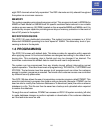1.6
eight DSP channels when fully expanded. The DSP channels are fully shared throughout
the system as a common resource.
MEMORY
The system operates using stored program control. This program is stored in EPROMs for
MEM3 or Flash Media for a MEM4 card. All specific customer data is stored in non-volatile
random access memory (NV-RAM) located on the removable MEM3 and MEM4 card. It is
protected by a super capacitor providing seven days of memory protection in the event of
loss of AC power to the system.
MICROPROCESSORS
The iDCS 100 uses distributed processing. The system’s primary processor is a 16 bit
Motorola® MC68000 operating at a clock speed of 16MHz. The secondary level of pro-
cessing is done in the keysets.
1.3 PROGRAMMING
The IDCS 100 comes with default data. This data provides for operation within seconds
after applying power. All trunks and stations are assigned according to the default num-
bering plan. This numbering plan is flexible and may be changed if so desired. The
technician customizes this default data to meet the end user’s requirements.
The system can be programmed from any display keyset without interrupting normal
system operation. There are three levels of programming: TECHNICAL, CUSTOMER and
STATION. The technician level has access to all programs and can allow the customer
access to system programs as needed. Technician and customer access are controlled
by different security passcodes.
The iDCS 100 also allows the use of a proprietary computer program called PCMMC. This
permits a technician to program the system using a personal computer. PCMMC can be
used on-site to modify the customer database or to download (save) the entire customer
database to a file. This file can then be saved as a backup and uploaded when required
to restore the database.
Through the use of modems, PCMMC can access an iDCS 100 system remotely (off-site)
to make database changes or perform uploads or downloads of the customer database
as if the technician were on-site.
HOME
PAGE
Table of
Contents


















